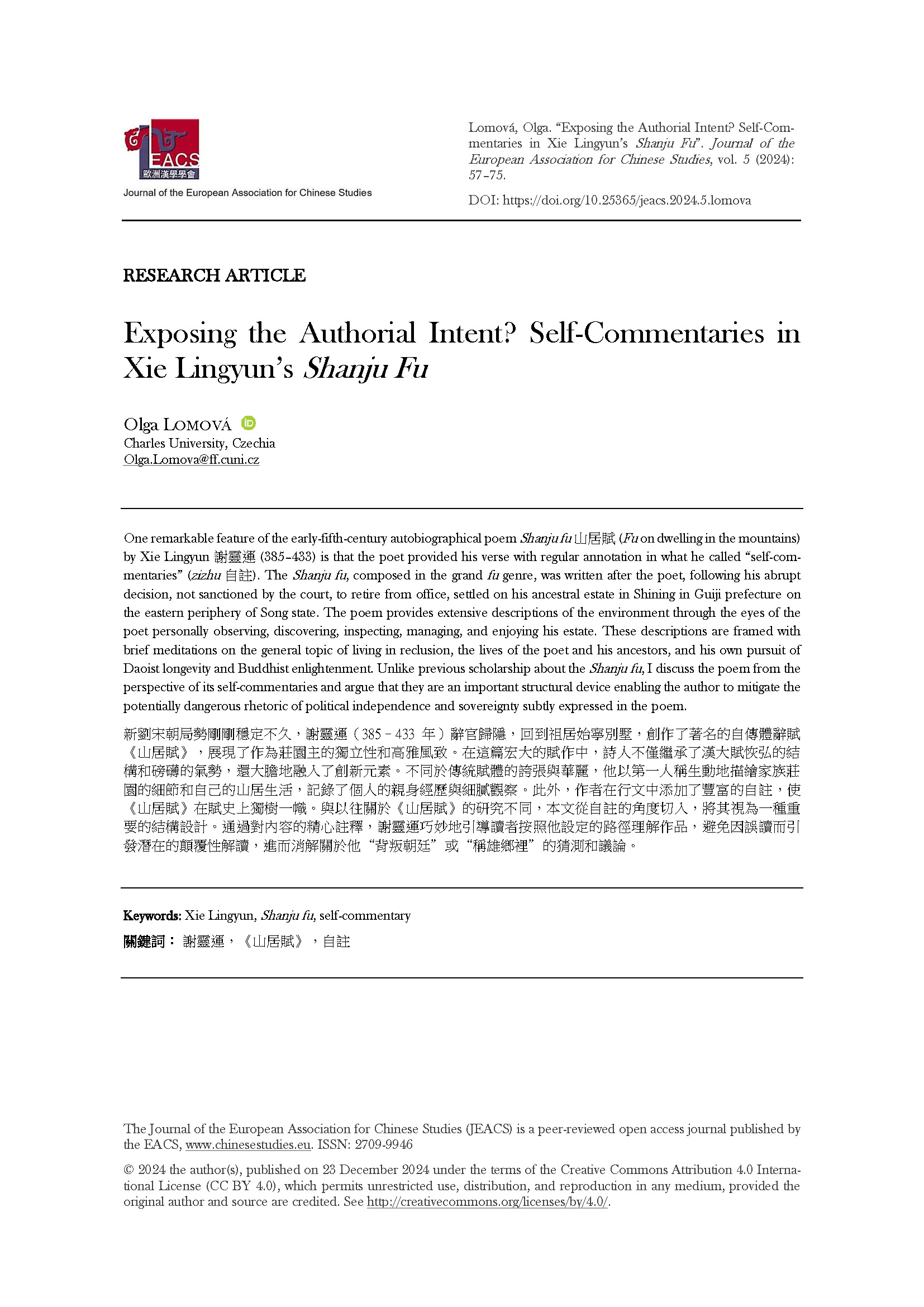Exposing the Authorial Intent?
Self-Commentaries in Xie Lingyun’s Shanju Fu
DOI:
https://doi.org/10.25365/jeacs.2024.5.lomovaKeywords:
Xie Lingyun, Shanju fu, grand fu, self-commentaryAbstract
One remarkable feature of the early-fifth-century autobiographical poem Shanju fu 山居賦 (Fu on dwelling in the mountains) by Xie Lingyun 謝靈運 (385–433) is that the poet provided his verse with regular annotation in what he called “self-commentaries” (zizhu 自註). The Shanju fu, composed in the grand fu genre, was written after the poet, following his abrupt decision, not sanctioned by the court, to retire from office, settled on his ancestral estate in Shining in Guiji prefecture on the eastern periphery of Song state. The poem provides extensive descriptions of the environment through the eyes of the poet personally observing, discovering, inspecting, managing, and enjoying his estate. These descriptions are framed with brief meditations on the general topic of living in reclusion, the lives of the poet and his ancestors, and his own pursuit of Daoist longevity and Buddhist enlightenment. Unlike previous scholarship about the Shanju fu, I discuss the poem from the perspective of its self-commentaries and argue that they are an important structural device enabling the author to mitigate the potentially dangerous rhetoric of political independence and sovereignty subtly expressed in the poem.
新劉宋朝局勢剛剛穩定不久,謝靈運(385–433年)辭官歸隱,回到祖居始寧別墅,創作了著名的自傳體辭賦《山居賦》,展現了作為莊園主的獨立性和高雅風致。在這篇宏大的賦作中,詩人不僅繼承了漢大賦恢弘的結構和磅礴的氣勢,還大膽地融入了創新元素。不同於傳統賦體的誇張與華麗,他以第一人稱生動地描繪家族莊園的細節和自己的山居生活,記錄了個人的親身經歷與細膩觀察。此外,作者在行文中添加了豐富的自註,使《山居賦》在賦史上獨樹一幟。與以往關於《山居賦》的研究不同,本文從自註的角度切入,將其視為一種重要的結構設計。通過對內容的精心註釋,謝靈運巧妙地引導讀者按照他設定的路徑理解作品,避免因誤讀而引發潛在的顛覆性解讀,進而消解關於他“背叛朝廷”或“稱雄鄉裡”的猜測和議論。
Downloads
References
Cheng, Yü-yü. 2017. “Text and Commentary in the Medieval Period.” In The Oxford Handbook of Classical Chinese Literature (1000 BCE–900 CE), edited by Wiebke Denecke, Waiyee Li, and Xiaofei Tian, 123–31. Oxford: Oxford University Press.
Cheng Yü-yü 鄭毓瑜. 2008. “Shenti xingdong yu dili zhonglei – Xie Lingyun ‘Shanju fu’ yu Jin Song shiqi de ‘shanchuan’, ‘shanshui’ lunshu” 身體行動與地理種類——謝靈運〈山居賦〉與晉宋時期的「山川」、「山水」論述. Tamkang Journal of Chinese Literature 16, 6: 37–70.
Cheng, Yü-yü. 2007. “Bodily Movement and Geographic Categories: Xie Lingyun’s ‘Rhapsody on Mountain Dwelling’ and the Jing-Song Discourse of Mountains and Rivers.” The American Journal of Semiotics, Vol. 23: 1–4, 193–219, 376–377.
Chennault, Cynthia. 1999. “Lofty Gates or Solitary Impoverishment? Xie Family Members of the Southern Dynasties.” T'oung Pao, Second Series, 85, Fasc. 4/5: 249–327.
Elvin, Mark. 2008. Retreat of the Elephants: An Environmental History of China. Yale University Press.
Frodsham, John D. 1967. The Murmuring Stream: The Life and Works of the Chinese Nature Poet Hsieh Ling-Yün (385–433), Duke of K'ang-Lo. 2 vols. Kuala Lumpur: Univ. of Malaya Press.
Gu Shaobo 顧紹柏, ed. 2004. Xie Lingyun ji jiao zhu 謝靈運集校註. Taipei: Le Jin.
Hawkes, David. 1985. The Songs of the South: An Anthology of Ancient Chinese Poems by Qu Yuan and Other Poets. London: Penguin Books.
Hu Wusheng 胡武生. 2013. “Xie Lingyun Shanju fu de yishu tezheng jiqi fu shi yiyi” 謝靈運山居賦的藝術特徵及其賦史意義. Journal of Hubei University (Philosophy and Social Science), 40. 2: 43–46.
Jin Wujiang 金午江 and Jin Xiangyin 金向銀. 2009. Xie Lingyun Shanju fu shi wen kao shi 謝靈運山居賦詩文考釋. Beijing: Zhongguo wenshi chubanshe.
Kirková, Zornica, and Lomová, Olga. 2022. “Beautiful Stones and Exotic Objects: The Symbolism of Things in Early Medieval China.” In Josef Hrdlička and Mariana Machová, eds. Things in Poems, 71–89. Praha: Karolinum.
Knechtges, David R. 2012. “How to View a Mountain in Medieval China,” Hsiang Lectures on Poetry, 6: 1–56. https://arcade.stanford.edu/content/how-view-mountain-medieval-china.
Knechtges, David R. 1996. Wen Xuan, or Selections of Refined Literature. Princeton: Princeton Uni-versity Press.
Legge, James. 1991. The Chinese Classics, Vol. IV, The She King. Taipei: SMC Publishing.
Li Yunfu 李運富, ed. 1999. Xie Lingyun ji 謝靈運集. Changsha: Yue Lu shushe.
Makeham, John. 2003. Transmitters and Creators: Chinese Commentators and Commentaries on the Analects. Cambridge. Mass.: Harvard University Asia Center.
Martin, François. 2000. “Le poète, les grues, les filles de l'onde. Xie Lingyun entre folklore et littéra-ture.” Études chinoises, 19.1–2 [Mélanges de sinologie offerts à Jean-Pierre Diény (II)] (Printemps-Automne 2000): 271–310.
Owen, Stephen. 2004. “The Librarian in Exile: Xie Lingyun’s Bookish Landscapes.” Early Medieval China 1: 203–226.
Qian Zhongshu 錢鍾書. 1999. Guanzhui bian 管錐編. 5 volumes. Beijing: Zhonghua shuju.
Schimmelpfennig, Michael. 2004. “The Quest for a Classic: Wang Yi and the Exegetical Prehistory of his Commentary to the Songs of Chu.” Early China 29: 111–162.
Song shu 宋書 (History of the Song). [488] 1974. Beijing: Zhonghua shuju.
Swartz, Wendy. 2018. Reading Philosophy, Writing Poetry: Intertextual Modes of Making Meaning in Early Medieval China, Cambridge, Mass.: Harvard University Asia Center.
Swartz, Wendy. 2015. “There's No Place Like Home: Xie Lingyun's Representation of His Estate in ‘Rhapsody on Dwelling in the Mountains’.” Early Medieval China 21: 21–37.
Swartz, Wendy. 2010. “Naturalness in Xie Lingyun’s Poetic Works.” Harvard Journal of Asiatic Stud-ies 70. 2: 355–386
Westbrook, Francis Abeken. 1973. “Landscape description in the lyric poetry and Fuh on dwelling in the mountains of Shieh Ling-yunn.” PhD. diss., Yale University.
Zhao Hongxiang 趙宏祥. 2016. “Zizhu yu zi zhu: jian lun Liuchao fu de zizhu” 自註與子註 : 兼論六朝賦的自註, Wenxue Yichan, XX 2: 65–74.
Zhou Zhenfu 周振甫, ed. 1986. Wen xin diao long jin yi 文心雕龍今譯. Beijing: Zhonghua shuju.
Zhuangzi ji shi 莊子集釋. 1978. Beijing: Zhonghua shuju.
Zuo Tradition Zuozhuan 左傳. 2016. Translated by Stephen W. Durrant, Wai-yee Li, and David Schaberg. Vol. 3. Seattle: University of Washington Press.

Downloads
Published
How to Cite
Issue
Section
License
Copyright (c) 2024 Olga Lomová

This work is licensed under a Creative Commons Attribution 4.0 International License.
